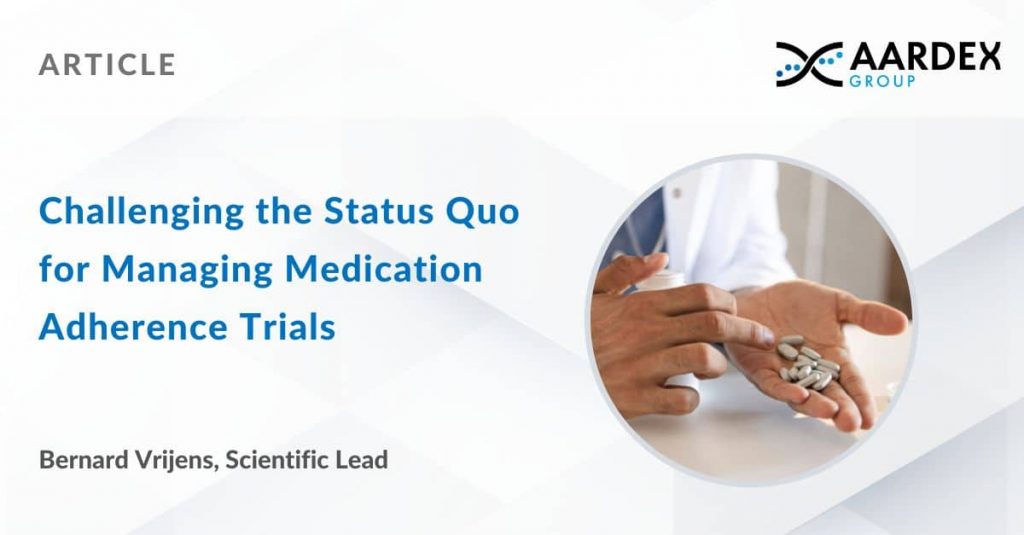Poor adherence to the investigational product can bring even the most carefully planned clinical trial to its knees. It is time to accept that traditional approaches such a pill count do not work. We need to upset the status quo by embracing the potential of modern medication adherence management.
Suboptimal medicine taking behavior, which affects around 30% of all trial participants by day 90,1 reduces effect size and increases variability, draining painstakingly calculated study power and resulting in non-significant findings.
A 2012 review of six HIV pre-exposure prophylaxis (PrEP) product trials demonstrated this perfectly, by showing a direct correlation between medicine taking behavior and recorded drug efficacy. An oral FTC/TDC for women (FEM-PrEP) with an adherence rate of less than 30% reported an efficacy of just 6%, whereas another, of Truvada, achieved an adherence rate of 96% and an efficacy rate of 100%. This was despite the products being similar in mode of action.2
Growing awareness
Sponsors who neglect to manage this important source of variation leave themselves open to wholly avoidable study failure. When we consider the expense of modern clinical trials, and that just 13.8% of products entering industry-sponsored Phase I trials ever go on to obtain FDA approval,3 it is clear why pharma is starting to acknowledge the impact of poor medication adherence in clinical trials. They need to give their candidates every chance of success.
Recently, drug giant Pfizer said study participants not adhering to their investigational product regimen was “corrosive to the integrity of the trial itself”. It increases the number of patients required to complete a study, prolongs study length, and drives up costs, as well as masks important safety signals and greatly complicates trial execution, said the organization’s chief medical officer, Dr Freda Lewis-Hall.4
It is a similar story at Novartis, which has highlighted the role of poor medication adherence in the fight against the current cardiovascular disease (CVD) epidemic. Speaking as part of a company-sponsored video series, Dr Steven Nissen, researcher, patient advocate, and chairman of cardiovascular medicine at the Cleveland Clinic, explained that CVDs are the leading cause of mortality the world over, accounting for 32% of all deaths.5 This is despite the emergence of highly effective, evidence-backed drugs for primary and secondary prevention, such as statins and angiotensin-converting enzyme (ACE) inhibitors, he said, adding: “We have powerful drugs, but they don’t work if you don’t take them…the problem is adherence.”6
Regulators are also placing an additional emphasis on adherence rates. The FDA’s 2019 Enrichment Strategies for Clinical Trials to Support Determination of Effectiveness of Human Drugs and Biological Products, for instance, said that reliable patient adherence data “provided valuable safety and efficacy information”. As such, more attention should be paid to this information during regulatory review, it went on.7
Traditional approaches
Tackling a problem like medication adherence requires the right tools for the job but, until relatively recently, they have been in short supply.
Pill count has been a mainstay of dose tracking for decades. Its accuracy, however, has been in question for more than 30 years. Back in 1989, researchers compared adherence as recorded by pill count to that as measured by plasma phenobarbital concentration in 216 patients from three separate studies. They found that 161 appeared to have between 90% to 109% compliance by return tablet count, yet, of these, 51 (32%) had plasma phenobarbital concentrations less than 90% of the lowest value previously found in normal volunteers. The authors concluded that return tablet count “grossly overestimates compliance”, and this finding has been reproduced multiple times in the intervening years.8
Self-report, which relies on the study participant’s memory making it vulnerable to recall bias, is equally problematic. The trial included in the HIV PrEP review that returned a statistically insignificant efficacy rate of just 6%, for example, recorded self-reported adherence at 83%, but this figure stood at 30% when measured by blood concentrations.2
Measuring drug and drug metabolites in blood, urine, or hair, however, is far from an ideal approach. Aside from their invasive nature making them burdensome for patients and sites alike, it is also subject to the ‘white-coat adherence’ adherence effect.9 This short-term escalation in adherence during the few days prior to a scheduled clinic visit means results can only provide a snapshot of medicine taking behavior at the stipulated timepoint.
Crucially, traditional approaches cannot provide the holistic, granular data needed to not only monitor, but to manage medication adherence during clinical trials.
Connected solutions
Enrichment Strategies for Clinical Trials to Support Determination of Effectiveness of Human Drugs and Biological Products outlined two approaches that could help in the quest to improve adherence in modern clinical trials.
The first was identifying and selecting patients with good adherence patterns, via a run-in phase ahead of trial initiation, though this is rarely used in the industry. The second was to encourage medication adherence throughout the study with adherence prompts and alert systems, and tools such as smart pill bottles, or medication adherence packaging.7
Combining medication adherence packaging with powerful data analytics takes this approach one step further by giving teams all the information they need to spot red flags and take meaningful action – long before poor adherence has a chance to affect study results.
Microcircuitry in the packaging, whether it be a connected inhaler, capsule bottle, or pre-filled syringe, records dose administration and other essential information, and automatically transmits it to the study team. Our cloud-based platform, MEMS AS®, then uses sophisticated algorithms to analyse medication-taking behaviour, and flag any erratic dosing patterns, such as overdosing, missed doses, or medication holidays.
This information, which includes participant risk stratification & prevention, is presented to the study team as data visualizations, allowing them to plan and deliver individualised corrective interventions.
Importantly, it is evidence based. Studies have shown that it is 97% accurate, compared to 60% for pill count, 50% for healthcare professional rating, and just 27% for self-report.10
In practice: Data-driven feedback
That which can be measured can be improved – and more 30 papers have shown that utilizing electronic monitoring data to inform adherence feedback works.
Study investigators and patients discuss the data during the scheduled appointments, with a view to understanding the reasons behind the patterns. This enables the design and delivery of individualized interventions – whether they be reminder messages for the forgetful or education for the concerned. It is an approach can be further enhanced by training the investigators in methods such as motivational interviewing.
One review and meta-analysis of 79 randomized clinical trials (RCTs) that electronically compiled drug dosing histories found the sharing dosing patterns to be most important adherence-influencing factor. In fact, interventional studies that included focused patient/ study team discussions around medicine taking behavior were 8.8% more effective than those that did not include feedback. This resulted in an average 20% overall improvement in adherence, and in some patients, this figure was as high as 50%.11
Sponsors are increasingly looking at digital adherence solutions to optimize their drug development and provide regulators with solid information on drug exposure. The granular, holistic data generated during electronic monitoring meets this need perfectly.
Digital future
Poor adherence to the investigational product is a long-standing, stubborn challenge in clinical trial execution. While the industry has long been well aware of the frequency and consequences of patients deviating from the protocol, however, a lack of workable solutions has meant the problem has been largely ignored.
Advanced, digital approaches that utilize the power of medication adherence packaging and powerful data analytics are now starting to challenge the status quo for medication adherence. This evidence-based model enables study teams to not only measure, but manage, adherence in real time throughout the trial and beyond.
It holds huge potential for sponsors wanting to truly understand and demonstrate the efficacy and safety of their products, and give their expensive, investigational candidates every chance of success.
References
- Eliasson, L., Clifford, S., Mulick, A., Jackson, C., & Vrijens, B. (2020). How the EMERGE guideline on medication adherence can improve the quality of clinical trials. British Journal of Clinical Pharmacology, 86(4), 687-697.
- Baeten, J. M., Donnell, D., Ndase, P., Mugo, N. R., Campbell, J. D., Wangisi, J., … & Celum, C. (2012). Antiretroviral prophylaxis for HIV prevention in heterosexual men and women. New England Journal of Medicine, 367(5), 399-410.
- Wong, C. H., Siah, K. W., & Lo, A. W. (2019). Estimation of clinical trial success rates and related parameters. Biostatistics, 20(2), 273-286.
- Pfizer. (2022) Clinical Study Adherence. Available at: https://www.breakthroughchangeaccelerator.com/clinical-study-adherence Last accessed: 10 August 2022.
- World Health Organization. Cardiovascular diseases. (n.d.) Available at: https://www.who.int/health-topics/cardiovascular-diseases#tab=tab_1 Last accessed: 10 August 2022.
- John Tsai. Home [LinkedIn page] Retrieved 10 August, 2022, from https://www.linkedin.com/feed/update/urn:li:activity:6909501556614651904/
- US Food and Drug Administration. (2019). Enrichment strategies for clinical trials to support determination of effectiveness of human drugs and biological products guidance for industry. Center for Drug Evaluation and Research (CDER).
- Pullar, T., Kumar, S., Tindall, H., & Feely, M. (1989). Time to stop counting the tablets?. Clinical Pharmacology & Therapeutics, 46(2), 163-168.
- P Podsadecki, Thomas J., et al. ““White coat compliance” limits the reliability of therapeutic drug monitoring in HIV-1—infected patients.” HIV clinical trials 9.4 (2008): 238-246.
- El Alili, M., Vrijens, B., Demonceau, J., Evers, S. M., & Hiligsmann, M. (2016). A scoping review of studies comparing the medication event monitoring system (MEMS) with alternative methods for measuring medication adherence. British journal of clinical pharmacology, 82(1), 268-279.
- Vrijens, B. (2019). A Six Sigma framework to successfully manage medication adherence. British Journal of Clinical Pharmacology, 85(8), 1661.



